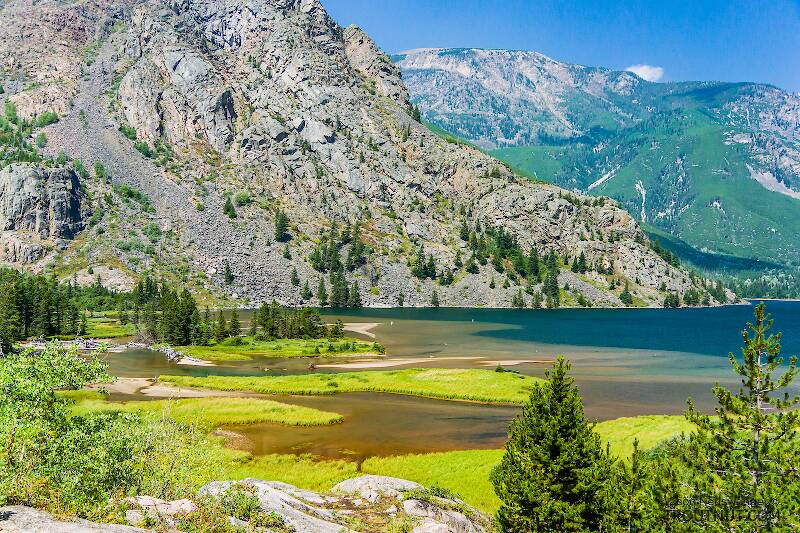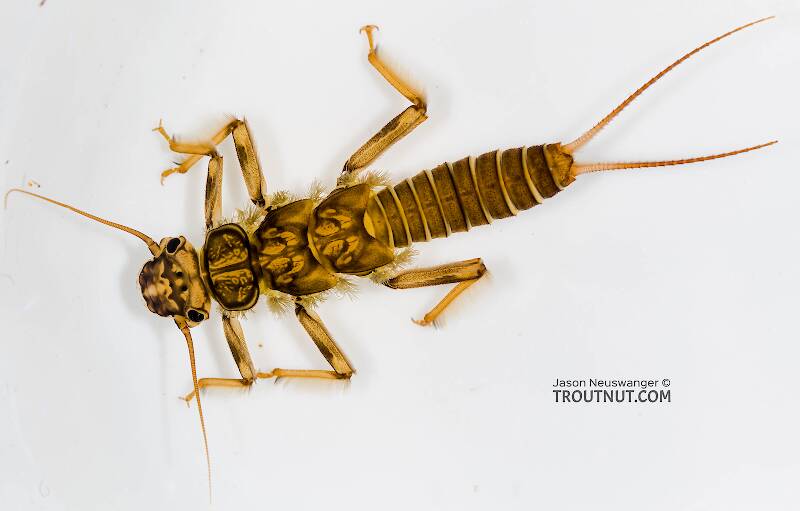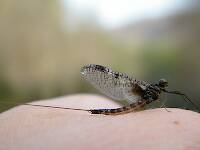
Blue-winged Olives
Baetis
Tiny Baetis mayflies are perhaps the most commonly encountered and imitated by anglers on all American trout streams due to their great abundance, widespread distribution, and trout-friendly emergence habits.
Featured on the forum

Troutnut is a project started in 2003 by salmonid ecologist Jason "Troutnut" Neuswanger to help anglers and
fly tyers unabashedly embrace the entomological side of the sport. Learn more about Troutnut or
support the project for an enhanced experience here.
David82nd on Jun 16, 2017June 16th, 2017, 9:23 am EDT
Been wondering for awhile on this figured perhaps somebody may share some input ? Like animals in the wild most have specific " territory or areas they will live,roam hunt etc. it's my understanding that they will stay in these areas for the most part ? The trout I see while in the river make me consider this , if trout are territorial and stay in specific areas of that river. Until spawning migration ? Is it a mile ? 5 miles ? I don't know , do they cruise the runs and go back to the beginning of the runs and start back up into it again ? Any input guys ?
David82nd on Jun 18, 2017June 18th, 2017, 1:53 am EDT
Hmmm. Hope you guys are on the river and don't think my question is ridiculous? Lol.
Wbranch on Jun 18, 2017June 18th, 2017, 2:00 am EDT
Packing for two weeks in Montana and to tell you the truth I just never gave it very much thought.
Catskill fly fisher for fifty-five years.
David82nd on Jun 18, 2017June 18th, 2017, 3:01 am EDT
Enjoy that trip. Would love to fish there , be safe keep us posted
Wbranch on Jun 18, 2017June 18th, 2017, 4:15 am EDT
David,
I made my first trip to Montana in 1968. I stayed for one month and fished primarily on Armstrong Spring Creek, which was free back then, and Nelson's Spring Creek which had two sessions. Dawn to 1:00 and 1:00 to dark. We always selected the afternoon to night session as the PMD's never started to emerge before 1:30.
That first year I also fished many of the streams and rivers in YNP. I also fished the middle Madison for a few days during the Salmon Fly emergence. Then over to Dillon to fish the Beaverhead and a couple of secret spring creeks.
Starting in 1969 I would drive my VW Campmobile on June 01 and fish pretty much every day until Labor Day. I did that for four years. I fished virtually everywhere in SW Montana. I have never fished, even to this day, the NW waters on the other side of the Continental Divide.
Since 1972 I have typically gone out for between 10 -14 days. In the late 1980's and early 1990's I had a love affair with the Big Horn. It's fame grew to gargantuan proportions and I left the love of my life (only to find even better water far to the west) For the last twenty years I fish exclusively on the Missouri River. I fish primarily between the dam at Holter Lake to a few miles below Craig. A distance of about ten miles.
I have caught more 22" - 24" brown trout and rainbows 20" -21" in the Missouri than all the other rivers combined that I have fish in Montana, New York, or Pennsylvania.
I made my first trip to Montana in 1968. I stayed for one month and fished primarily on Armstrong Spring Creek, which was free back then, and Nelson's Spring Creek which had two sessions. Dawn to 1:00 and 1:00 to dark. We always selected the afternoon to night session as the PMD's never started to emerge before 1:30.
That first year I also fished many of the streams and rivers in YNP. I also fished the middle Madison for a few days during the Salmon Fly emergence. Then over to Dillon to fish the Beaverhead and a couple of secret spring creeks.
Starting in 1969 I would drive my VW Campmobile on June 01 and fish pretty much every day until Labor Day. I did that for four years. I fished virtually everywhere in SW Montana. I have never fished, even to this day, the NW waters on the other side of the Continental Divide.
Since 1972 I have typically gone out for between 10 -14 days. In the late 1980's and early 1990's I had a love affair with the Big Horn. It's fame grew to gargantuan proportions and I left the love of my life (only to find even better water far to the west) For the last twenty years I fish exclusively on the Missouri River. I fish primarily between the dam at Holter Lake to a few miles below Craig. A distance of about ten miles.
I have caught more 22" - 24" brown trout and rainbows 20" -21" in the Missouri than all the other rivers combined that I have fish in Montana, New York, or Pennsylvania.
Catskill fly fisher for fifty-five years.
Jmd123 on Jun 18, 2017June 18th, 2017, 10:31 am EDT
David, trout are indeed territorial. The biggest one in the reach will occupy the best feeding/shelter habitats; the next biggest one will occupy the second best habitat; and so on down the hierarchy, the little guys being forced out into the middle by larger fish who won't let them hide (or might eat them!). They will certainly change locations during spawning time unless their home range is near a nice gravel riffle. Otherwise, they will move to find riffles for spawning, and they will move to find colder water (e.g., springs, colder tribs) during the heat of summer. I have also heard that fish caught and released will often move afterwards because they now associate that location with a "bad experience" and don't want it to happen again. This would not surprise me, but I have no data or even anecdotes on it. Perhaps others on here have some experiences to relate?
Jonathon
Jonathon
No matter how big the one you just caught is, there's always a bigger one out there somewhere...
David82nd on Jun 18, 2017June 18th, 2017, 10:40 am EDT
Thank you jonathon, puts things in perspective. , makes sense ,
Afishinado on Jun 18, 2017June 18th, 2017, 10:54 pm EDT
Below is a really interesting and informative article titled "Wild Trout are Travelers" detailing when, why, where and if trout move in our streams and rivers:
http://www.patrout.org/docs/reference-materials/traveling_trout.pdf?sfvrsn=2
http://www.patrout.org/docs/reference-materials/traveling_trout.pdf?sfvrsn=2
David82nd on Jun 18, 2017June 18th, 2017, 11:12 pm EDT
That's a nice read , thank you
Quick Reply
Related Discussions
Topic
Replies
Last Reply
0
Jun 4, 2016
by Wiflyfisher
by Wiflyfisher
7
Jun 25, 2019
by Wbranch
by Wbranch






